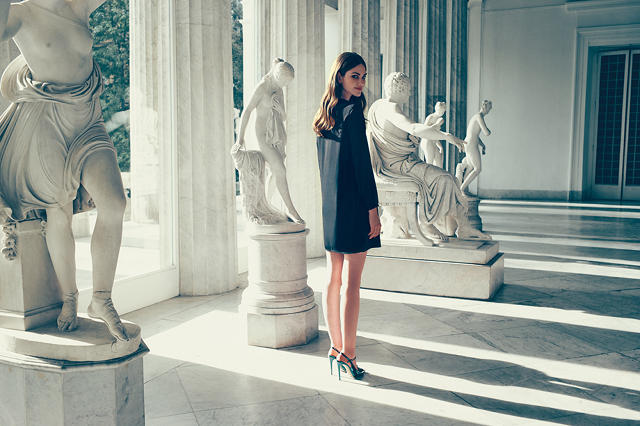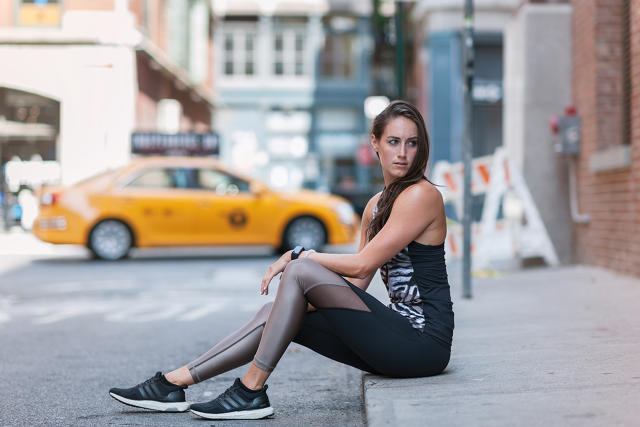No More Athleisure, Brick And Mortar, Made in China? How Fashion Will Change In 2017
Change is afoot in the fashion industry.
We’ve already seen glimpses of how the tectonic plates in the fashion world are moving. In one of our best-read fashion stories of 2016, we explored how some of the premium U.S. fashion brands of the past—Tommy Hilfiger, Calvin Klein, Ralph Lauren—have lost their luster.
They’re losing ground to a new generation of direct-to-consumer brands that were born on the internet, including Everlane, Cuyana, M.Gemi, DSTLD, American Giant, and Vrai & Oro. These companies are offering something different from the flashy designers of (January 12, 2017): the insight into their supply chain and sometimes even a breakdown of their sales margins, providing the customer with a better understanding of the quality they’re getting for their money.
Over the next year, we’ll see how these online brands continue to transform the fashion landscape. We’ll see big shifts in brick and mortar stores, fashion supply chains, the athleisure trend, and the idea of value.

1. Brick And Mortar Makes A Comeback
Awesome online and in-store experiences give rise to the “super customer.”
When online shopping took off a decade ago, pundits predicted that physical shops would disappear. It turns out that brick-and-mortar stores have remarkable staying power, but their purpose has fundamentally changed as fashion brands try to figure out how physical retail outlets fit in to the shopping experience. “Brands are thinking about what the internet cannot give you,” says Katia Beauchamp, CEO of beauty subscription service Birchbox, pointing out that digital tools now allow you to come close to seeing, touching, and even trying on products.
In Beauchamp’s view, the one thing the internet does not provide is human contact. She predicts that in 2017, customers will increasingly visit stores to get curated experiences from shop representatives. For brands to meet this demand, they need to have well-trained staff who understand products inside and out and can offer personalized advice.
We will also see a rise in experiential retail, according to Michelle Cordeiro Grant, the founder of underwear brand Lively. To encourage consumers to spend time in their stores browsing their products, brands will get more creative, adding amenities like bars, coffee shops, and yoga classes. In other words, stores will become more like entertainment spots for people who share similar lifestyles and interests to spend time together. “There will be an emphasis on physical brand experiences that will enable consumers to engage with not just product, but brand ethos and community,” she says. “The main objective of this kind of blending will be brand awareness, but the scope and reach will be much more than what’s been traditional. These experiences will be leveraging what is happening with social and taking it offline.”
Direct-to-consumer luxury shoe company M.Gemi says that fashion companies that understand how brick-and-mortar intersects with digital will see the rise in the “super customer.” M.Gemi launched a pop-up store in New York earlier this year and found that customers who had a good experience in-store would eventually spend more online and return fewer products than digital-only customers. Similarly, digital customers who went to stores would purchase 33% more in-store than new customers. “The website and the store seemed to be mutually reinforcing,” says Cheryl Kaplan, M.Gemi’s president.
Now M.Gemi is making the most of these insights by opening additional shops and creating a more seamless experience between digital and brick-and-mortar. For instance, a customer will be able to leave a store and find all the shoes that she tried waiting in her online shopping cart. “This is just the first of many ways we’re experimenting with bringing these two experiences together,” she says. She believes these efforts will generate even more “super customers.”

2. We Finally Ditch The Term “Athleisure”
It’s just how we dress.
Last year, the “athleisure” trend became so widespread that the word was officially added to the Merriam-Webster dictionary. The awkward portmanteau refers to athletic clothing that can be worn during leisure activities (i.e., everyday life)—a style kickstarted by Lululemon, creator of yoga pants you could wear to brunch. In the last few years, dozens of new athleisure companies—Bandier, Outdoor Voices, Alala—have entered the market, selling high-performance activewear designed to be worn outside the gym.
But ironically, just as the term enters the official lexicon, some say it won’t be necessary because athleisure has become so ubiquitous. “In 2017, athleisure as a concept will simultaneously cease to exist and be everywhere, as it is assimilated into consumers’ lifestyles and wardrobes,” says Denise Lee, founder of Alala. “I see it becoming less of a trend and more of a normal way of life.”
Gregory Lowe, the founder of Fitbox, an activewear subscription service in which Rebecca Minkoff has recently invested, concurs. “It is not a trend,” he says. “It’s a new way of life sparked by millennials’ interest in being stylish and comfy at the same time.” Lowe thinks that from now on, all apparel brands will be designing clothes with comfort and performance in mind, while the athleisure market will continue to become more complex. Some lines will focus on fashion and luxury (see: Prabal Gurung Sport and Cushnie et Ochs’s capsule collection). Others, such as Adidas’s line, will be primarily focused on using advanced technical materials.
Nina Faulhaber, the cofounder of the athleisure brand ADAY, also believes that customers are increasingly looking for high-tech garments they can wear to work. “In the post-athleisure world, consumers want the benefits of athleisure without the ‘I just went to the gym’ vibe,” she says. “Comfort and versatility will be hiding in everyday garments. The less of a spandex look, the better.”
This year, ADAY launched a pair of leggings that are designed to be worn throughout the day, even in professional contexts. Made of moisture-wicking fabric, they have a matte finish that does not look like nylon or spandex and have lots of useful features, including special pockets for your cell phone. One woman wore hers in a meeting with British Prime Minister David Cameron, Faulhaber says.

3. Value Matters More Than Labels
Customers are smart and want to know what they are paying for.
In 2010, Warby Parker and Everlane were among the first brands to make transparency a key part of the customer experience. They offered products at lower prices than designer alternatives, and emphasized the importance of quality through brand storytelling. They explained that by cutting out middlemen and selling through their own channels, they could save the customer money.
These days, customers expect to know exactly what they are paying for. Many upstarts that recently entered the market—bag brand Oliver Cabell, denim brand DSTLD, jewelry brand Vrai and Oro—have all adopted the direct-to-consumer model. “Quality and value are increasingly sought after, more so than specific brand-name or luxury-brand status,” says Karla Gallardo, founder and CEO of women’s fashion label Cuyana. “This is a new type of ‘value’: It no longer necessarily means low prices for low quality, but rather low prices for high quality—made possible by being direct-to-consumer.”
Gallardo believes that over the next year, companies that build their business model on making large wholesale margins will struggle to compete with this new flock of brands. Consumers are also losing interest in big discounts since they often come paired with lower-quality products. Gallardo says that brands struggling to survive in this shifting landscape—including J.Crew and the Gap Brands—will need to rethink their entire supply chain so they are making high-quality products with the best materials, then selling them at the best possible prices. This means not only being “direct-to-consumer” but also “direct-to-supplier.”

4. Made In America
More production is returning home.
President-elect Trump ran on a platform of bringing more jobs back to the U.S. by eliminating free trade deals. It’s unclear whether he will actually follow through on these promises—and whether Congress will work with him to bring them to fruition—but the fashion industry is already thinking about how such legislation could change their business. The majority of U.S. fashion brands have moved production to Asia, where labor costs are lower. But there’s been a shift in recent years as a wave of startups have chosen to make products in U.S. factories because it allows them to better monitor quality and take advantage of the most recent manufacturing technology. The possibility of higher tariffs on overseas manufacturing may prompt more fashion brands to follow the startups’ lead and head back to the U.S.
Bayard Winthrop, the founder and CEO of American Giant, a brand that makes all of its products in the U.S., believes that the U.S. government’s efforts to bring more jobs back by introducing tax breaks and benefits is only part of the solution. American companies need to be able to make products locally so efficiently and cost effectively that they are able to compete with foreign manufacturers. “The focus needs to be on fostering competitiveness,” he says.
To do this, Winthrop says that fashion brands need to reimagine every aspect of their supply chain, so that they are able to make a high-quality item at a good price. This sometimes means upgrading factory technology so that the machines are more efficient and require less human intervention. It might mean sourcing materials locally to cut down on shipping costs. “Brands that are nimble and driving change have much lighter cost loads and are freed from this accelerating downward pressure,” he says. “There is room for them to be responsive and innovative.”
The good news for companies committed to making products locally is that U.S. consumers welcome this change. They want high-quality products, which American factories often can deliver more easily than their Asian counterparts because of U.S. access to cutting-edge technology. According to the 2016 McKinsey Millennial Survey of 11,000 U.S. customers, quality was a top driver of purchasing behavior. As a result, the “fast fashion” model, which was fueled by cheap overseas manufacturing, is waning. “The more time you spend wearing or even just looking at fast fashion as a category, the more aware you become of the shit quality,” Winthrop says. “This idea of ‘newness’ is dampened by poor make. The signal change is that a growing segment is purely interested in quality, less is more, and owning fewer things.”
DSTLD, an L.A.-based denim brand that makes most of its products in local factories, has made the same observation. “[Customers] are looking at where items are made, how products are made, and the materials that go into each product,” says cofounder Corey Epstein. He says the brand has found that customers are attracted to its commitment to sustainability, zero sweatshops, and reducing the impact fashion is having on the world.
In the upcoming year, Epstein thinks that companies and consumers will both take a “less-is-more” approach to fashion. “More and more brands are focusing on smaller, more timeless product lines,” he says. “We’re not trying to make the cheapest white T-shirt, but the most well-constructed, best-fitting, softest T-shirt, at the absolute best price.”
Fast Company , Read Full Story
(33)














